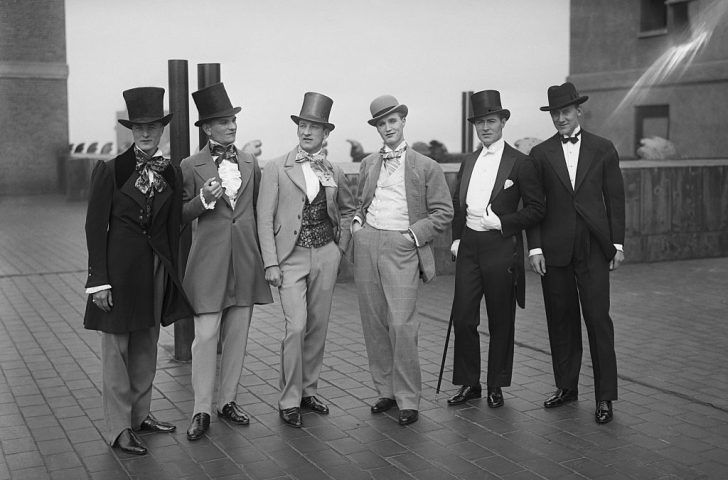The 1920s men's fashion was a remarkable blend of elegance and innovation. It set the stage for modern menswear. Known as the 'Roaring Twenties,' the 1920s was characterized by significant social changes and economic prosperity. Something that was reflected in the clothing styles of the time.

Elle / The 1920s men's fashion was dominated by the classic suit, which underwent significant transformations during the decade.
Early in the 1920s, suits featured high-waisted trousers and jackets with wide lapels. This style was influenced by the need for comfort and functionality post-World War I.
As the decade progressed, suits became more streamlined. By the late 1920s, trousers were narrower and jackets were more fitted. Thus, reflecting the decade's inclination towards a sleeker silhouette. Fabrics like tweed, herringbone, and flannel were popular, often in muted colors like gray, navy, and brown.
Knitted garments, such as cardigans and sweaters, gained popularity, especially for leisure activities. This period marked a shift towards comfort without sacrificing style. The introduction of the polo shirt by René Lacoste in 1926 revolutionized casual wear. These casual pieces often featured bold patterns and brighter colors, a departure from the conservative tones of formal wear.

Getty / While the suit remained a staple, the 1920s also saw the rise of more casual styles in men's fashion.
The Influence of Jazz Culture on the 1920s Men’s Fashion
Sure! The influence of jazz culture on 1920s men's fashion cannot be overstated. Jazz musicians and their vibrant lifestyles inspired a more relaxed and flamboyant approach to dressing. The "Jazz Suit" featured a longer jacket and baggier trousers. Thus, allowing for more freedom of movement, ideal for dancing.
Accessories like wide-brimmed hats, bow ties, and suspenders were commonly seen. Thus, adding a touch of flair to the ensemble. This fusion of style and music created a dynamic fashion landscape that was as exciting as the jazz rhythms themselves.
The Choice of Footwear and Accessories Back in the 1920s
Footwear in the 1920s was as stylish as the clothing. Two-tone shoes, often in black and white, were a hallmark of the decade. These shoes were typically worn with both casual and formal outfits, showcasing the versatility of 1920s men's fashion. Accessories played a significant role as well. The pocket square became a must-have. Thus, this added a pop of color and sophistication to any suit.
Men's hats, particularly fedoras and flat caps, were essential for completing the look. Watches and cufflinks were also popular. It highlighted the era's attention to detail and refinement.

GTN / Hollywood had a significant impact on 1920s men's fashion. The silver screen introduced audiences to a new level of glamour and sophistication, influencing everyday styles.
Movie stars like Rudolph Valentino and Douglas Fairbanks became style icons, with their on-screen wardrobes setting trends. Men aspired to emulate their favorite actors, adopting the tailored suits, slicked-back hairstyles, and polished shoes seen in films. This connection between cinema and fashion helped spread new trends quickly and widely. Thus, solidifying the influence of Hollywood on global fashion.
The 1920s brought a youthful revolution to men's fashion. Young men, inspired by a desire to break from tradition, embraced more daring and unconventional styles. The Oxford bags, wide-legged trousers named after their popularity among Oxford University students, became a symbol of youthful rebellion.
Paired with blazers or knitwear, these trousers were both comfortable and stylish. This era also saw the rise of sportswear as everyday attire, reflecting a growing interest in physical fitness and outdoor activities. The fusion of youthful exuberance and fashion innovation defined the decade.






